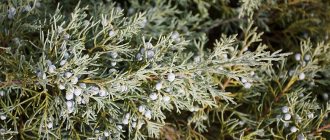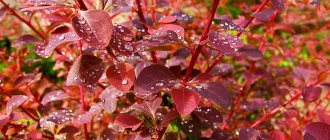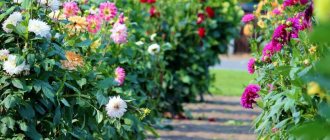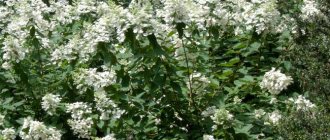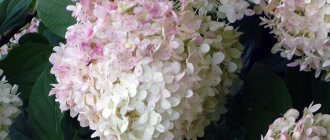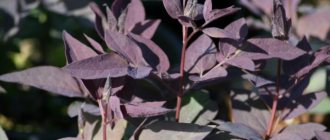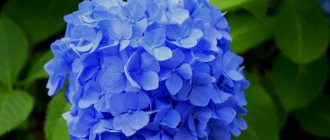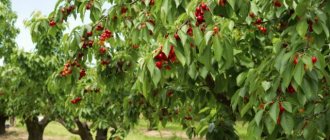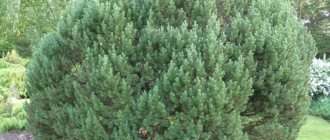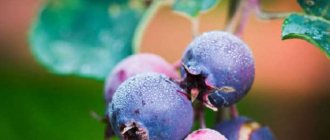Domestic gardeners pay special attention and interest to dukas, that is, cherry-cherry hybrids created by Russian and foreign breeders. In terms of taste, the fruits of representatives of this culture are closer to cherries, but are distinguished by increased sweetness and lack of astringency. For example, Duke "Miracle Cherry", which has long been grown in the southern regions of our country, has joined the list of early summer varieties with high yield potential, excellent taste and appearance of berries.
"Miracle cherry" brings abundant harvests of large, very attractive and tasty fruits
It is known that the shortened name “Duke” (translated as “Duke”) appeared and took root in Russian gardening thanks to the spread of the cherry variety “Maidyuk” (“English Early”, “Duke of May”), cultivated in England back in the 17th century.
“Miracle Cherry”, like other hybrid dukes, has not received official recognition in the form of registration in the State Register of the Russian Federation, and there is also no reliable data on its licensing and certification in the CIS countries. According to reviews, the variety is widespread in Russia in regions with temperate and warm climates, as well as in the southern and central regions of Ukraine. A general idea of its most significant features can be obtained from the table:
| Parameter | Characteristic |
| Culture | Duke is an interspecific hybrid of common cherry (Pgunus cerasus L.) and sweet cherry (Pgunus avium L.) |
| Variety | "Miracle Cherry" |
| Tree height | 2.5-5 m (depending on the rootstock) |
| Precociousness | 4-5 years after planting |
| Fruit ripening time | Early: June 1-8 in the Krasnodar region; June 21-30 in the south of the Central Black Earth zone |
| Type of fruiting | Mixed: on bouquet branches and on last year’s growth |
| Fruit weight | About 6.7-8 g (maximum 10 g) |
| Productivity | High, regular; on average 11-14 kg (maximum up to 28.5) per tree, about 9.6-11.9 t/ha |
| Appearance of fruits | Large, flat-round, dark red |
| Pulp/tasting assessment of taste qualities | Medium-dense, dark red, sweet, with cherry aroma / 4-4.5 points (out of 5) |
| Purpose of fruits | Dessert (universal): fresh consumption, use for making juice, jam, marmalade, compotes, dried fruits |
| Sustainability | Frost-resistant (up to −28 ℃), heat- and drought-resistant; in unfavorable years it is affected by coccomycosis to a moderate degree (1.1-1.7 points), highly resistant to moniliosis (0.6 points) |
| Registration in the State Register of the Russian Federation | Absent |
The difference between a hybrid and traditional cherry varieties
The hybrid of cherries and sweet cherries has a number of distinctive features:
- foliage is larger, close in appearance to cherry;
- branches are large and straight, foliage is glossy, even in shape;
- the buds are dense and large, more like cherry buds;
- crown and branching pattern of branches - cherry;
- flower buds are formed during annual growth, due to which the plant bears fruit every year.
Cherry cherry has relatively good winter hardiness, the plant has strong immunity, due to which it can be grown in those regions where, due to the humid climate, fungal diseases often occur.
History of origin and development
When cherries ripen in the middle zone
Many sources indicate that the first cultivators appeared in Great Britain in the 17th century. In particular, one of the successful hybrid varieties was named “May-duke” (May Duke). Over time, the name lost the first part, and we have a simple short name - duke.
It should be noted that although the variety was not winter-hardy and bore fruit for only 2-3 years, many gardeners of that time wanted to get a new crop. In particular, it was cultivated in our Caucasus under the name English early. The first Duke was distinguished by larger fruits than cherries and early ripening.
At the end of the century before last, French breeders isolated two varieties, also obtained after accidental cross-pollination. Without any stretch of the imagination, they could be called cultural. Dukes are called like this:
- Queen Hortense;
- Empress Eugenia.
In our country, the first cherry tree was bred by Ivan Vladimirovich Michurin
In our country, the first cherry tree was bred by Ivan Vladimirovich Michurin, which is not surprising. The great breeder crossed the Belle cherry and the Winkler white cherry. The resulting hybrid is called Beauty of the North. It was distinguished by increased frost resistance and was grown in various regions from the Moscow region to Western Siberia. Unfortunately, winter thaws turned out to be destructive for the buds, and the variety did not take root.
Later, Michurin created the Chernaya Chernaya consumer goods variety. This duke produced larger berries, and the buds on the plants did not freeze. The trouble was the low cherry yield.
Michurinsky variety Shirpotreb black
Further development of breeding work in the direction of cherry in the USSR was resumed only in the 80s of the last century. Currently, the most successful varieties have been bred under the leadership of Alexander Ivanovich Sychov, a breeder from the Belgorod region, General Director of Agro LLC.
Main characteristics of culture, advantages and disadvantages
Brief description of cherry:
- The plant has a height of about 6 m. This can cause some inconvenience when picking berries located high up.
- The bark is black with a gray tint and rough to the touch.
- The leaves are straight, oval in shape.
- Inflorescences - consist of 3 flowers. The flowers are large, spoon-shaped, and the color is pure white.
- The berries are dark red, with juicy pulp and sweet juice, sourness is present, but in minimal quantities. Fruit weight is about 6 g.
Additional Information! Black cherry is a self-fertile plant that needs to be planted near suitable pollinators.
Cherry cherry is very tall, with a large crown; when planting, this must be taken into account in order to choose an area with enough space for it
Cherry benefits:
- sweet and juicy fruits;
- ease of care;
- good tolerance to adverse conditions and temperature changes;
- frost resistance.
The species has no significant disadvantages. The only disadvantage of cherries is that it is inconvenient to harvest from a tall plant.
Positive and negative sides
Amateur gardeners and specialists, when expressing their opinions about the variety, pay attention to its valuable characteristics :
- consistently high productivity;
- taste qualities of fruits and beautiful presentation;
- versatility of use;
- increased resistance to coccomycosis and moniliosis;
- good tolerance to heat and drought;
- frost resistance corresponding to the conditions of southern and temperate climates.
It is advisable to purchase seedlings from local nurseries that provide maximum adaptation to climatic conditions
Among the disadvantages are:
- 100% dependence on pollinating partners;
- poor resistance of flower buds to return frosts;
- tallness;
- average early pregnancy.
When purchasing and planting a seedling, you need to take into account weather and climatic conditions and try to choose a place in the garden that is most suitable for this hybrid. For example, in regions with warm winters, it is better to plant a tree in the fall. Sunny open areas are suitable for placing cherry trees, where it is possible to leave free space within a radius of 4-5 meters around the tree. The soil should be fertile and well drained.
A tree planted in a prepared hole filled with nutrient soil mixture is watered abundantly with water (at least 2-3 buckets)
Further agrotechnical measures are carried out according to standard rules for caring for stone fruit crops - weeding and loosening the tree trunk, timely watering, especially during dry periods, pruning and shaping the crown, fertilizing, as well as preventing diseases and pests, including rodents.
For those who are interested in cherry-cherry hybrids, we also invite you to get acquainted with the varieties of the ancient Ukrainian duke “Shpanka”.
Popular cherry varieties, their brief description
The hybrid has several varieties, each of which has its own characteristics.
Miracle cherry
Description of Cherry Miracle:
- medium-sized plant, round crown, average leaf density;
- Fruiting occurs on bouquet branches and on annual growths;
- The berries are large, weighing about 8-9 g.
A distinctive feature is the juicy, very tasty pulp, which has a dessert-like taste.
Spartan
Medium-sized cherry with a spreading crown. The leaves are large, the fruits are small, weighing about 5-5.6 g. Ripening is average. Winter hardiness is very high.
Additional Information! The disadvantage of Spartanka is the wet separation of the fruits, without tails, which is why the crop is not suitable for transportation and long-term storage.
Nurse
The fruits are large, from 7 to 8 g, the pulp is sweet and sour. The advantage is very high frost resistance.
Planting DUK cherries in spring
Spring is the best time to plant dukes. This must be done before the buds open, i.e. during the tree's hibernation period. It is necessary to wait for positive night and day temperatures, at least plus five degrees. There is no point in waiting for the ground to thaw. After the snow melts, the seedlings can be planted, as the root system takes root well and the tree is at rest. Planting dates depend on climatic conditions, from the end of March to April. This should be done early in the morning or late evening, preferably in cloudy weather without wind.
Benefits of spring planting:
- As the tree grows, problems that arise quickly can be eliminated - pests, diseases, timely moisture.
- The root system quickly adapts, and the tree begins to grow.
- The possibility of preparing the planting site in the fall so that the soil has time to settle, which will help avoid deepening of the root collar.
The disadvantages of spring planting include possible return frosts, which harm all garden crops.
In Russia, in the southern regions, dukes are planted in March-April. In the middle zone - the second part of April. In the Urals and Siberia - in late April-early May.
Cherry pollinators
To pollinate the hybrid, it must be planted next to the following cherries:
- Kentish;
- Lada;
- Black large.
Additional Information! Neighborhood with Kent cherries will produce berries of a rich red color, excellent quality and with sweet pulp.
The combination of a hybrid with Black or Lada will give a harvest of large and sweet fruits
Pollinators for the miracle of the DUK cherry
To successfully cultivate cherry trees, it is necessary to plant pollinating trees nearby. The following cherry varieties are suitable for this: Yaroslavna, Donchanka, Nezhnost. Some gardeners like Priusadennaya, Annushka, Sister, Donetsk Uglek. You can also count on insects that need to be attracted. To do this, the crown of the dukes is sprayed with water in which sugar is dissolved in an amount of twenty grams per liter of water. Special preparations also work well, for example, Ovary and Bud.
Without the use of pollinators, self-fertile varieties can produce only five percent of the planned harvest.
Features of growing, planting and caring for crops
Its further development and productivity depend on how correctly the Duke miracle cherry is planted. The landing process itself is not complicated:
- prepare a hole in fertile soil - depth about 80 cm, diameter about 1 m;
- insert the seedling into the hole, straightening the root system, the root collar should be several centimeters above ground level;
- cover with soil, water - 2 buckets of water are enough for one plant.
Fertilizers before planting that are applied to the ground:
- ash;
- potassium;
- superphosphate.
If the soil is poor, additional compost or humus is added to it.
If several hybrids are planted, the distance between them should be at least 5 m.
Attention! For planting, you need to choose seedlings 1 or 2 years old.
Caring for the plant is not difficult:
- watering - once a month;
- application of fertilizers - once every 30-40 days;
- sheltering the hybrid for the winter in the first year after planting.
The frequency of watering depends on weather conditions. In summer, the soil is moistened 2 times a month, or as the top layer of soil dries completely. The soil should be moistened to a depth of about 45 cm.
When caring for a hybrid, attention should be paid to the correct application of fertilizers; replenishment is used according to a certain scheme:
- organic - suitable only for adult plants, it is added to the top layer of soil, no more than once every 4 years;
- mineral compositions - used once every 12 months;
- potassium and phosphate - 1 time per season.
Attention! Fertilizers should not be used often. An excess of nutrients is no less destructive for a plant than a lack of them.
If the hybrid is sick, additional root feeding can be done to restore it.
Suitable soil types
Suitable soil for the hybrid should have neutral or medium acidity. If the pH is high, you can lower it by adding lime to the soil. The soil should be loose and light; if it is heavy, add sand in equal parts.
Description of the plant, characteristics of pollination and fruiting
The tree is vigorous, about 4-5 m in height, has a highly rounded, spreading, well-leafed crown . The bark on the trunk and main branches is smooth and dark brown. Annual shoots are thick, powerful, with large buds. The leaves are green, large (cherry type), but dense, like a cherry. During the flowering period, in the second half of April, the tree is abundantly covered with large white flowers.
Early flowering is associated with a high risk of damage to the ovaries by return frosts
Early fruiting is assessed as average: trees on a seed rootstock begin to bear fruit in the 3-4th year after planting. From the fifth year, a high rate of increase in yield is observed, the maximum indicators last until 15-18 years, after which a sharp decline occurs. Ovaries are formed at the ends of annual growths and bouquet branches, which is important to consider when pruning.
The productivity of mature trees is quite high: at the level of 9.6-11.9 t/ha. From one young tree you can collect 2-4 kg per season, and from a 7-8 year old tree - up to 23.5-28.5 kg.
Alexander Ivanovich Sychov, the author of a number of varieties of stone fruit crops and the head of the Belgorod nursery Rostok, tells in more detail about the fruiting of Duke “Miracle Cherry” in the following video:
Since the plant is self-sterile , to obtain guaranteed yields, it is recommended to have other pollinating varieties nearby, for example, “Rubinovaya” and “Alaya” cherries, “Bulatnikovskaya” and “Molodezhnaya” cherries.
Experts point out that dukes do not pollinate each other, but show abundant ovary production in the presence of cherry trees that bloom at similar times, and somewhat lower productivity in joint plantings with cherries.
Resistance to adverse conditions, diseases and insects
The hybrid has high disease resistance. But the occurrence of diseases cannot be ruled out due to improper care of the plant:
- Milky shine - the plant is treated with iron sulfate or copper sulfate.
- Cherry scab - Bordeaux mixture, copper chloride, Nitrafen or Cuprozan are used for treatment.
- Moniliosis - spraying with copper sulfate.
Insects - aphids, sawflies, cherry flies. Insecticides are used to combat them.
The plant's resistance to adverse weather conditions is high.
If the plant is sick, branches damaged by the fungus must be pruned to prevent the spread of the disease.
Botanical description
A tall tree that requires the formation of a crown, since in natural conditions it stretches strongly upward and has a pyramidal crown.
On the brown powerful branches of the plant there are leaves resembling cherry leaves in shape, but larger in size. Same as cherry. However, the dark green color of the cherry leaves has transformed into the rich emerald color characteristic of cherry trees.
Duke blooms very beautifully - with white or pink large flowers collected in brushes. In central Russia and in more northern regions, flowering occurs in June.
Duke Hodosa
An excellent variety with dessert berries that are used in the confectionery industry. Amazing jams and preserves, marmalade and candied fruits, decorating tarts and cakes with fresh fruits. The variety owes its birth to the breeder A. Sychov, who managed to create a unique fruit tree that is not afraid of frost or drought, giving a bountiful harvest every year! Disease resistant.
Duke Spartan
It has an exquisite taste, sweetness and juiciness. An adult tree bears fruit every year and gives the gardener a generous harvest of very large berries that are resistant to the vagaries of the weather, which is why they got their name. Breeders A. Sychov and A. Taranenko took part in the creation of the variety. The fruits of Spartanka make excellent compotes for the winter and delicious liqueurs.
Duke Torch
It is very easy to maintain, since even an adult tree rarely exceeds 3 meters in height. Harvesting does not cause much trouble. The berries are very juicy, large, sweet and sour. Housewives are happy to use them for preparing compotes for the winter, as well as for home production of liqueur with an unforgettable aroma. It grows without problems in northern latitudes and can withstand air temperatures of almost minus 40 degrees.
Duke Nadezhda
Incomparable, large, sweet berries of a very dark color with the same dark pulp. An adult tree produces a rich harvest - about 20 kg of selected berries. And at the same time the plant is frost-resistant. It only does not tolerate waterlogging due to the high level of groundwater.
External features of dukes
Duke fruits are truly magnificent - large, decorative, juicy. The hybrid reflects the best of two wonderful cultures. The piquant aroma and richness of cherries, as well as the juiciness, sweetness and tenderness of cherries. The size of the berries was inherited from cherries - they are much larger than cherries.
Harvesting and storage
Harvesting occurs around the second half of June. Fresh berries are stored in the refrigerator for about 10 days. For long-term storage, the fruits can be frozen; after defrosting, they will not lose their taste and beneficial properties.
The harvest is used for processing - jams and preserves, compotes, liqueurs and wines are prepared from the berries.
Miracle cherry is a unique plant, a cherry-cherry hybrid with very tasty berries - sweet, but also with a recognizable cherry sourness. Caring for the plant is not difficult. Juicy berries are not only tasty, but also have a number of useful properties - they prevent the growth of cancer cells and have a beneficial effect on the digestive system.
What is Duke
Cherry-cherry hybrids appeared by accident. The fact is that in the mild European climate the conditions for growing these stone fruit crops are most suitable. So they grew in the gardens in the neighborhood, where they simply could not help but cross-pollinate due to their close biological relationship. One should not belittle the merits of European breeders who noticed the similarity of the trees and conducted experiments to obtain a new species.
Most of the hybrids did not have a good berry taste; many simply did not bear fruit. But still, some successfully crossed plants stood out, which later received the name cherry or duka.
This is interesting: European farmers and ordinary people often call the berries quite banally: sweet cherries (cherries) and sour cherries (cherries).
Cherry cells have 32 chromosomes, while sweet cherries have only 16. As a result of disruption of cell division of cherry plants under the influence of cherry pollen, a duke appears containing the same 32 cherry chromosomes.
It is not surprising that from a genetic point of view, cherry is closer to cherries. In particular, this is manifested in the following qualities:
- taste of berries with cherry sourness;
- increased frost resistance;
- similarity in leaf shape.
Externally, the fruits and leaves of duka are practically no different from ordinary cherries.
Hybrid varieties with description and photo
Today, breeders have already developed many varieties of cherry. Here is a description of the best of them:
- Miracle cherry . Possesses abundant and early fruiting. This drought-resistant fruit tree is sensitive to frost, so it is recommended for the southern regions.
- Excellent Venyaminova . It can be grown in the Non-Black Earth Region. The variety produces high but irregular yields and forms a vigorous tree with dense, fleshy fruits. Fruits in the mid-late period.
- Donetsk spanka . Self-pollinating variety, which is rare. It produces many pink fruits with yellow flesh inside.
- Saratov baby . A mid-early variety that forms a medium-sized tree. Produces high yields of fruits, which are located mainly inside the crown.
- Spartan . Has high frost resistance. Dark red fruits ripen in the middle period.
- Ivanovna . A mid-late variety with good frost resistance and excellent taste of large fruits.
- Fesanna. Its berries have an excellent taste, but the tree is sensitive to frost.
- Portly. Gives high yields in medium terms. The berries are dark red, tasty and large.
- Night. Its fruits are dark red and are resistant to fungal diseases. Medium late variety.
- Pivonya . It has excellent yield and tasty dark-colored fruits.
- Spectacular . Its fruits have a rich cherry flavor. Sensitive to the sun and needs to whitewash the trunk to avoid spring burns.
Planting a tree
This fruit tree can be planted in autumn and spring. Autumn planting is acceptable for residents of the southern regions, but in other areas it should be planted in the spring so that the cherry seedlings take root well and prepare for the cold. For these fruit trees, you should choose a place well lit by the sun, without cold winds, with a depth of groundwater no closer than 2 m to the surface. There should be no stagnation of water in the selected location.
Soils with a neutral reaction are preferable.
Selection of seedlings
Seedlings should be purchased from specialized nurseries or from reputable sellers. The choice should be made on zoned varieties.
Two-year or three-year-old seedlings with a developed root system will take root well. Such a tree has a trunk of approximately 0.6 m and several shortened branches.
Important! The tree should not show signs of disease or damage, peeling bark, stains, or growths.
Soil preparation and planting
For spring planting, it is more convenient to prepare the hole in the fall or at least a month before planting. A hole is dug with a diameter of about 1 m and a depth of 0.8 m. If several trees are planted, a distance of 5 m is maintained between them. When digging holes, the top fertile layer is immediately laid aside separately, in order to then make a mixture of soil and fertilizers. As nutrients, you can take 3 cups of wood ash, 300 g of superphosphate and 250 g of potassium sulfate. Humus is added to poor soil, and sand is added to heavy soil, and drainage is made from crushed stone.
The seedling is placed in the hole and watered. A mound of prepared soil mixture is poured at its bottom. Then they place a tree on it, straighten its roots and carefully cover it with soil. At the same time, the earth is compacted so that there are no voids. After planting, the root collar should be at ground level and under no circumstances be buried. The seedling is tied to a support and a hole is formed around it.
Similar varieties
Cherry Miracle is not the only duke that is grown in Russia. At the moment, more than 20 similar varieties are known:
Alice is a medium-late variety and quite productive;- Donetsk giant is an early hybrid with a berry weight of up to 12 grams;
- Beauty of the North - early ripening, berry weight averages 8 grams;
- Khodosa is a mid-season hybrid, the fruits reach 7 grams;
- Ivanova – medium late variety, good taste;
- Nurse - high-quality winter-hardy duke, etc.
Secrets of care
The variety is drought-resistant, but trees, especially in hot weather, need to be watered regularly. Young plantings are moistened once every 7 days at a rate of 40 l/plant. For fruit-bearing trees to grow normally, watering three times a day is sufficient, before flowering, during fruit formation and after harvesting. With each watering, the water should wet the soil to a depth of 80 cm. In the fall, moisture-charging irrigation is carried out to increase winter hardiness. It is better to supply water through a drip system or into watering ditches (60 l/plant). In extreme heat, it is advisable to use sprinkling with sprinklers, which moistens not only the soil, but also the crown.
During the ripening period, watering is not carried out so that the fruits do not crack.
After watering, the soil under the crown should be weeded and loosened to a shallow depth - 6–10 cm near the trunk, without damaging the roots. Then mulch is laid - hay, sawdust.
Note: tansy planted along the perimeter of the crown will repel weevils, pyrethrum will drive away aphids, and celandine will get rid of ants.
Top dressing
Fertilizers should be applied in doses; an excess of microelements, as well as a deficiency, weakens the plant. You should be especially careful with nitrogen fertilizers, which are applied only in the spring. After all, in the fall, such fertilizing significantly reduces winter hardiness.
In the first two years, dukes practically do not need additional feeding if they are planted on fertile soil. In the third year, in the spring, cherries are fertilized with urea (60 g/10 l), in the fall - with phosphorus-potassium fertilizer (30 g/10 l).
Fruit-bearing trees require 4 full meals a day per season:
- at the beginning of the season, add ammonium nitrate (20 g/1 m2);
- before the buds emerge - superphosphate (3 tbsp/10 l);
- after the flowers fall off - nitrophoska (50 g/10 l);
- when fruiting ends, fertilizing with potassium sulfate (100 g) and superphosphate (100 g/10 l) is carried out.
Before frost, humus is spread around the tree trunk. Every 4 years, deoxidize the soil with lime (500 g/1 m2).
Mineral fertilizers should be alternated with organic matter. In the spring, during the active growing season, plants are fed with a nitrogen composition - mullein (3 kg/30 l), chicken manure (2 kg/30 l). And during the period of fruit formation - ash (300 g/1 m2). Before cold weather, rotted manure is spread under the crown - 10 kg for a young plant and 25 kg for an adult.
To increase productivity and improve the taste of berries, it is recommended to spray the crown twice after flowering with Agricola-Fruit solution (50 g/10 l) with an interval of 14 days.
Preparing for winter
Cherry Miracle is frost-resistant. But in severe winters with little snow and during spring return frosts, flower buds can be damaged. To avoid this, cherries are sprayed with Novosil and Epin-extra before flowering and before the onset of autumn cold weather.
In the fall, it is necessary to whiten the trunk and skeletal branches; insecticides can be added to the solution. This whitewash will protect the tree from parasites and sunburn, and prevent cracking of the bark.
In areas with a warm climate, trees are not insulated; mulching with humus is sufficient. In cooler regions, plants are covered with spunbond and pine needles . Cherry trees are insulated at a temperature not exceeding 00C; when warmer weather sets in, the shelter is removed so as not to cause damping off of the shoots.
Fan watering (50–80 l/tree) and spraying the crown with water can mitigate the damage from the return of May cold snaps. Smoking will help protect a blooming garden from frost. In the morning hours, heaps of straw and dry manure are set on fire, which produce a large amount of smoke. As a result, the air temperature around the trees is adjusted by several degrees.
Trimming
Without pruning, the crown of the Miracle cherry tree stretches upward, acquiring a narrow pyramidal shape. Therefore, in early spring, overgrown branches should be trimmed, creating a beautiful compact crown that will be well ventilated and evenly warmed by the sun.
A distinction is made between pruning young and fruit-bearing trees. In young plantings, shortening is carried out mainly, which stimulates the growth of buds and shoots. The branches of fruit seedlings are cut to 1/3 of their length after planting, which promotes stronger branching. In fruit-bearing trees, intertwining branches are thinned out. They also shorten perennial shoots and annual growths to stimulate the development of bouquet branches.
There are several types of pruning: shaping, regulating, rejuvenating. Formative pruning is necessary for young plants. The most suitable type of crown for cherries is sparsely layered. When planting in spring, the trunk is shortened to 75 cm from the ground. The first tier is formed at the beginning of the next season from 3 branches, shortening them by a third. The trunk is cut at the level of the upper branches. A year later, a second row is formed from 4 branches at a distance of 70 cm from the first. Strong branches are cut by half, weak ones by 2/3, and the trunk is shortened. Next spring, the last tier of 3 branches is formed. The trunk is again cut to the height of the upper branches.
When forming the crown, you should pay attention to the angle of branches. Branches growing at an acute angle often break, creating deep wounds that lead to disease and even death of the tree. To form their growth in a horizontal direction, weights are tied to the branches or the ends of the shoots are tied to the trunk.
Regulatory pruning is carried out on trees with an already formed crown. Remove drooping branches, tops (shoots directed vertically), and completely cut off basal shoots. After leaf fall, dry and broken branches are removed. All cuts are treated with varnish, which protects the wood from rotting.
A tree older than 7 years needs rejuvenating pruning: all old branches are cut off, leaving only young shoots. This prolongs the life of the plant.
Disease prevention Miracle cherry
The variety is immune to many infections, is practically not affected by coccomycosis and moniliosis, and is rarely damaged by the cherry fly. However, preventive measures are necessary for the longevity of plantings and maintaining high yields.
| Diseases | Symptoms | Prevention | Treatment |
| Gommosis (gum discharge) | A light brown sticky substance called gum appears on the branches and trunk of the tree. The disease can be caused by broken branches or temperature changes. |
| Clean the affected areas and disinfect them with 1% copper sulfate. |
| Clusterosporiasis | The first sign of the disease is leaf spotting. Over time, holes with a red border form in place of the spots. |
|
|
| Gray rot | The disease progresses with high humidity. Gray formations appear on the branches and the fruits rot. |
|
|
| Powdery mildew | During drought, a light coating appears on the foliage and branches. Leaves fall and productivity decreases. |
|
|
Gommosis weakens the tree and reduces the quality of the crop
Clusterosporiosis can be identified by holey leaves
Wet weather promotes the development of gray rot
Powdery mildew disease is more active in hot, dry weather
| Pests | Manifestations | Prevention | Measures |
| Aphid | Aphids inhabit leaves and stems, feeding on their sap. Young shoots dry out and die. |
|
|
| Slimy sawfly | Caterpillars gnaw out the ovaries, damaged fruits fall off. |
| Treat before flowering with 10% Karbofos, after flowering with Endobacterin (100 g/10 l). |
| Flower beetle | The larvae chew out the bud, thereby weakening the flowering. Adults feed on foliage. |
| Spray the green cone with Fufanon (10 g/10 l). |
Colonies of voracious aphids quickly destroy leaves and shoots
Leaves damaged by slimy sawfly appear scorched.
The flower beetle chews out the buds, resulting in a decrease in yield
Pollinators Miracle Cherry
Cherry Miracle is self-sterile; without additional pollinators, only 5% of its fruits are set. Therefore, duke should be planted surrounded by cherries or cherries - only in this case can you get an annual harvest. The best pollinators are cherries, especially Iput, Nezhnost, Donchanka, Yaroslavna. You can also plant self-fertile cherry varieties nearby - Lyubskaya, Molodezhnaya, Bulatnikovskaya.
For better pollination during flowering, cherries are sprayed with a solution of honey (1 tablespoon/1 liter of water) - its smell will attract bees and bumblebees. It is useful to plant honey plants nearby: bluebells, lungwort, thyme. In cold rainy weather, flowers are poorly pollinated by insects, so you should additionally spray the crown with Ovary and Bud preparations.
How to prune a hybrid of cherries and sweet cherries (Cherevishnya)
Crown formation is an important point in obtaining beautiful and visually attractive plants. In the absence of shaping procedures, the crown will have a narrow, pyramidal configuration. There are several types of pruning that a tree needs:
- Formative. A crown of a certain variety and size is created. Skeletal and overgrowing branches are identified. Ideal for young crops that are developing strongly. Lasts until the start of fruiting. Until the age of 5, such pruning is carried out every year.
- Supportive. Guarantees preservation of crown parameters and support for better lighting levels. After reaching 30 centimeters in length of the shoots, balancing pruning is carried out between branches with fruits and vegetative ones.
- Restorative. They are used to restore plants after diseases, insect damage, and winter cold. Such pruning contributes to the restoration of crops.
As for shaping haircuts, the Miracle Cherry is tailored according to a sparse-tiered pattern. One-year-old seedlings will need to be pruned immediately after planting. Shortening of side shoots begins to 3-4 buds. The main shoot should be located 15 centimeters higher than the top growth point. The lower shoots along the trunk are shortened by 2/3 of the length. Haircuts can be carried out both in spring and summer. But the optimal period for such purposes is considered to be the end of February - the beginning of March. Temperatures must be at least +10 degrees.
You can learn more about pruning miracle cherries from this video.
